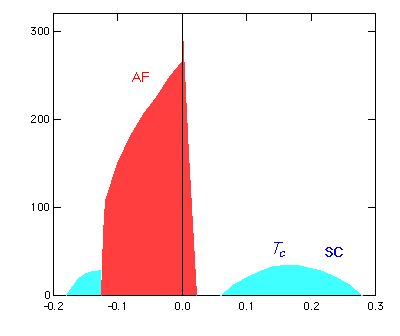The cuprate superconductors with high critical temperature Tc have the typical perovskite structure with the Cu-O two-dimensional plane (figures).
 
Crystal structures of La2-xSrxCuO4 (left) and
YBa2Cu3O y(right).
The phase diagram of high temperature superconductors is shown below.
In the low-carrier part, there is the anomalous metallic region where the susceptibility and 1/T1 show a
peak above Tc suggesting an existence of the pseudogap. To clarify an origin of the anomalous metallic
behaviors is a challenge for many physicists.
It has been established that the Cooper pairs of high temperature cuprates have d-wave symmetry in the hole-doped
materials. Several evidences of d-wave pairing symmetry has been also provided for the electron-doped cuprate
Nd2-xCexCuO4. It is expected that the superconductivity of electronic origin
is a candidate for the high temperature superconductivity. We also expect that the origin of d-wave superconductivity
lies in the on-site Coulomb interaction between d electrons.
The undoped oxide compounds exhibit rich structures of antiferromagnetic correlations over a wide range of
temperature. A small number of holes are responsible for the disapperance of long-range antiferromagnetic order.
Neutron scattering experiments have suggested an existence of incommensurate antiferromagnetism with modulation
vectors given by Qs = (&pi± 2&pi&delta,&pi) and Qc = (± 4&pi&delta,0) where &delta
denotes the hole density. The incommensurate correlations may be induced by holes doped into the Cu-O plane
in the underdoped region. A checkerboard-like charge-density modulation with a roughly 4× 4 period has also
been observed by scattering tunneling microscopy experiments in Bi2212 and Na-CCOC compounds.

Phase diagram of La2-xSrxCuO4 (hole-doped case, in the right-hand side)
and Nd2-xCexCuO4-&delta (electron-doped case, in the left-hand side).
The mechanism of superconductivity is not still resolved although many intensive studies have been presented. The origin of superconductivity certainly lies in the two-dimensional plane consisting of oxygen and copper atoms since the high-Tc oxides are quasi two-dimensional materials with large anisotropy. The superconducting gap has d-wave symmetry, and thus superconductivity originating from the on-site Coulomb repulsion is a candidate of high temperature superconductivity. The basic model of high-Tc cuprates is the three-band model with copper and oxygen orbitals that is called d-p model.
| |

